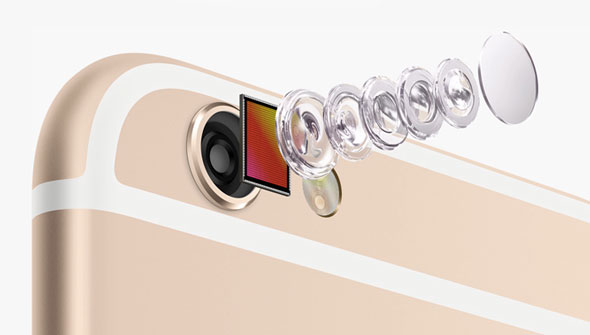Am in the market for an upgrade to my trusty old iPhone 3GS — right, not the latest piece of hardware, but still does what it’s expected to do. Android and Microsoft smartphone hardware is pretty amazing these days, just to mention the PureView technology the latter got from Nokia and the more innovative Google alternative to iOS. Also, Apple is known to hardly ever implement the best benchmark technology. The Apple experience isn’t about latest specs, it’s about seamless operation and unmatched fusion of hard- and software, designed from scratch by one company only with one aim in mind: ease of even complex use. So how well does the new upgraded iPhone 6 camera bode? Remember, it’s the visionaries from Cupertino with their reinvention of mobile photography who put the nail into the coffin of the camera industry as we knew it not too long ago.
The phone comes in two flavors: the iPhone 6 Plus with a 5.5-inch IPS LCD display and a user interface that has been optimized for the larger screen, and the smaller iPhone 6 4.7-inch screen and 1,334 x 750 pixel resolution which, in Apple terminology, makes it a “Retina HD” display.

Not surprisingly, Apple says its best camera got even better. 8MP is all you get, but who needs more? 8MP resolution dates back to the iPhone 4S and the same 1/3-inch sensor size as on the 5S. Aperture remains the same at F2.2. So what’s new?! Faster processing, more storage, the all-new Retina display. Plus the iPhone 6’s camera offers Focus Pixels, an Apple euphemism for autofocus, providing the sensor with more information about the image, giving better and faster autofocus that one can even see in preview. Nice. Not just on paper:
The new iPhones will make use of on-sensor phase detect autofocus. This is a significant upgrade from the contrast detect AF that is seen in the previous iterations. Apple says this will make the focussing system twice as fast as the iPhone 5S. That’s what they mean with Focus Pixels. It basically means on-sensor pixels which are dedicated to determine the focus distance, which reduces the twitching you see when cameras are trying to acquire focus with contrast detect AF.
And yes, each pixel measures 1.5µ, same size as the pixels on the iPhone 5S camera and not class-leading. The HTC One offers a 2µ pixel size, on a 4MP sensor. The iPhone beats the HTC when it comes to handling color depth, tone and saturation. HTC leaves the iPhone in the (noisy) dust when it comes to low light. But Apple has been focusing on the camera and everyday photography since years now, and this really starts to pay off with Apple promising better image processing and low light capabilities. Add the improved True Tone dual-LED flash for more accurate rendition.
That’s why the camera that changed photos does not the same for video. The iSight camera shoots 1080p HD video at 60fps and offers some pretty amazing super slow motion video (240fps!) and, for the first time, time-lapse videos with continuous autofocus providing constant focus — and cinematic video stabilization (OIS) on the iPhone 6 Plus.
This uses the gyroscope to detect any movement of your hand while you’re holding the phone to take a picture or shoot a video, with the A8 chip and M8 motion coprocessor adjusting the position of the lens unit to compensate for this motion. And burst mode for stills? 10fps, not too shabby.
The iPhone 6 captures more frames per second for potentially sharper, smoother videos — albeit ones that are likely to suck up more storage space. But now, in addition to shooting 1080p at 30fps, you can record Full HD at 60fps.
The world’s “most popular camera”, as Apple calls its iPhones, and this is actually backed by Flickr and other uploads, this world’s most used camera has a reasonably fast aperture, good dynamic range and obviously so much optical ingenuity packed into it that it protrudes a bit from the slim body. Performance above practicality.
Add the all new iOS 8 Photos app, allowing to adjust lighting and saturation with sliding scales that show what the photo would look like before you apply the changes. More, while Apple’s already made photos across devices pretty seamless with Photo Stream, there’s now a new option to “like” your own photo that’ll make the photo appear on all your Apple devices…
Some bet the iPhone 6’s new camera will even change filmmaking. “The iPhone has been here for a while, but in 2015 I think there’s going to be dozens, hundreds, of movies shot on the iPhone 6,” says Ricky Fosheim, the director of And Uneasy Lies the Mind, a feature film he made entirely on an iPhone 5 for $15,000.
We’re still far off the day when a pocketable smartphone camera replaces more serious and expensive tools. Yet, as it has been said again and again on this site, something’s wrong when the photographer depends on a camera. On the contrary, the camera depends on the photographer. The iPhone camera offers a kind of hybrid solution. A fool can operate it, but it still requires the eye to make this state-of-the-art optical technology shine.
And as first and foremost I’m buying a smartphone for its camera, this smaller iPhone 6 might well be the logical path to follow. Guess the Retina HD screen protected by “Ion-strengthened glass” will make everything look beautiful anyway.


